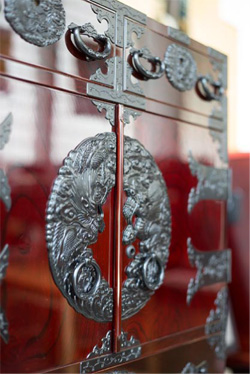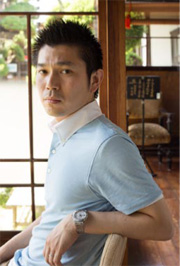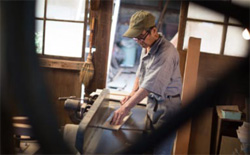Home > Highlighting JAPAN > Highlighting Japan SEPTEMBER 2012 > Monma Tansu: More than Mere Furniture
Highlighting JAPAN
[SERIES] JAPAN BRAND
Monma Tansu: More than Mere Furniture
Monma Tansu in Sendai, Miyagi Prefecture, is one of only two furniture studios in the regional capital still producing tansu chests in the traditional way. Gavin Blair speaks with Kazuhiro Monma, the seventh-generation owner of the firm.

Detail of the chest which won for Monma Tansu the Good Design Award 2011
Credit: JEREMY SUTTON-HIBBERT
During the Edo period (1603–1867), tansu were classified by what they were used for, with different types for clothes, swords and medicines. One of the most distinctive varieties was the kaidan-tansu, or stairs-chest, built in the shape of steps, so that the tansu would fit neatly in the stairwell and thus maximize use of space. In the subsequent Meiji period, tansu became increasingly ornate and decorative, with individual styles developing in different regions of Japan. One of the most highly regarded varieties of these is the Sendai Tansu, so called after the city of the same name in Japan's northeast Tohoku region.

Kazuhiro Monma
Credit: JEREMY SUTTON-HIBBERT
"The other things that set apart authentic Sendai Tansu are the use of local keyaki (Japanese Zelkova) wood and the lacquering applied to it that helps it last such a long time," says Monma Kazuhiro of Monma Tansu, one of only two makers of traditional Sendai Tansu remaining out of the 100 or so that once plied their trade around the city. "Though there are other companies which make similar tansu using materials and components from elsewhere."
"Our craftsmen apply around thirty layers of lacquer, which of course takes a lot of time and increases the cost of the tansu," explains Monma, who is the seventh generation of his family to be involved in the business, which can still be found in its original location in the center of Sendai City.
As well as the workshop where the tansu are crafted, the premises also house a tansu museum that doubles as a showroom, and is flanked by a traditional Japanese garden which is largely unchanged since the company was started in the nineteenth century.

A craftsman cuts wood in the workshop at Monma Tansu.
Credit: JEREMY SUTTON-HIBBERT
Over the years, Monma has attracted the interest of illustrious customers from General Douglas MacArthur (head of the allied occupation forces after WWII) to the French ambassador and the Empress of Japan.
For everyday folk, the chests can be a little pricey, concedes Monma, who has introduced items such as wine racks and even a mouse pad to make the company's products more accessible.
"We hope that these will get younger people in Japan interested in our goods, then, when they are older and have more money, they may want a Sendai Tansu," says Monma.
Having won a Good Design Award at home in 2010, the company has also begun to look overseas, exhibiting in Hong Kong in 2011 and Malaysia this year. However, the strong yen, shipping costs and import taxes all add to the already expensive prices for the tansu. Monma says he is currently working on ideas to make more affordable pieces for export.
After the tsunami of March 11 last year, which caused extensive damage to coastal Sendai, Monma Tansu began receiving water-damaged tansu to repair. Extracting the salt from the wood, repairing rusting iron fittings and getting drawers to open and close smoothly again, are the biggest challenges, according to Monma. Restoring these pieces, some of which are more than a century old, is clearly more than just a business to those involved.
"Sendai Tansu are more than furniture," says Monma," they are closer to art."
© 2009 Cabinet Office, Government of Japan






